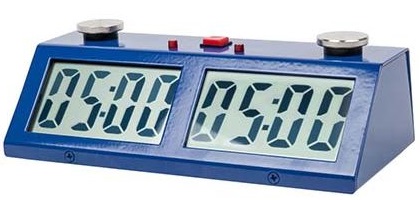There is some useful background information, including the historical development of electronic chess clocks, & accurate definitions of "Fischer", "Bronstein", & "simple delay" modes on the Wikipedia "Chess Clock" page. Here's a brief excerpt:
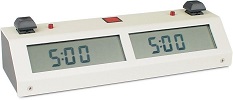
ChronosManual.pdf
|
- Rugged Metal Case
- LCD Display
- Three AA Batteries
- 12 User Programmble Operating Modes
- Available with Buttons or Touch Pads
- Widely regarded as the best chess clock ever
|
The Chronos (a.k.a. Chronos II, or Chronos Standard) is considered by many to be the best digital chess clock ever made. They are reliable, rugged & extremely flexible for programming functions. However, in addition to being somewhat confusing to program initially, they are a bit pricey & they have a history of being only internittently available even through major distributors. Chronos Clocks come in either a black, blue or beige metal case.
The Chronos clocks have 68 preset modes from which to choose. Each of these presets can be customized & saved into one of twelve user selectable presets. This may seem overwhelming at first, but in fact you'll find the vast majority of users rarely use more than four or five presets, & once these are set up, operation is simple & minor modifications are easy.
You can watch a six minute video on YouTube explaining how to set up a few typical user programs for your Chronos clock here: YouTube Video, "How to set the Chronos Chess Clock II". This will get you started & after you've set up a few presets for your favorite time controls, you'll most likely rarely if ever have to do any programming beyond occasionally changing a delay or beeper setting, which is really easy to do.
Back in December of 1999, Mark Kaprielian at Metrowewst Chess Club published a document "designed to help make sense of the many options available to the owners of the Chronos Clock". This document was revised in March of 2003 & posted on the MWCC site as Chronos_Clock_Tips.htm. A reformatted version with some minor typos corrected is presented here: MK-ChronosTips.html
Since FIDE time controls with increments are becoming more prevalent (in particular both RelyeaChess & Continental Chess Association frequently require increment time controls) & most typical club clock settings involve only delays,
instructions on how to set your Chronos clock for 40/90 SD30 inc30 for FIDE tournaments are presented here.
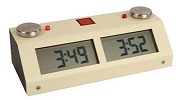
ChronosBlitzManual.pdf
|
- Compact Metal Case
- LCD Display
- Three AA Batteries
- 12 Programmble Operating Modes
- Available with Buttons or Touch Pads
|
The Chronos GX, or "Blitz" Model is almost identical to the Chronos Standard Clock except that the Blitz version has a shorter case & a smaller display which does not show the move counter. Both types of Chronos Clocks may have either buttons or touch sensitive pads for clock operation. The Chronos Blitz Clocks come in a variety of colors including black, beige, blue, & yellow.
Since FIDE time controls with increments are becoming more prevalent (in particular both RelyeaChess & Continental Chess association frequently require increment time controls) & most typical club clock settings involve only delays,
instructions on how to set your Chronos clock for 40/90 SD30 inc30 for FIDE tournaments are presented here.
If you are somewhat put off by the explanations offered in the abridged manual for the Chronos Model GX, you're not alone. However, I find the Blitz/GX model is actually easier to program than the standard model primarily because both the delay & increment settings are available in all of the "tournament" settings, so if you are using either delay or increment, but not both, yoou can just set the unused parameter to zero.
The good news is that all these features are explained on a couple YouTube videos. Here are two I like:
The complete set up guide to the Chronos GX 9:09
Chronos GX - how to access blitz and tournament modes 6:11
Take your pick, or watch both & you'll soon be a Chronos GX Xepert!
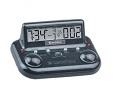
ExcaliburClockManual.pdf
|
- Rugged Compact Design
- LCD Display
- LED Indicators
- Four AA Batteries
- 91 Preset Operating Modes
- 5 User Programmable Modes
- Large Durable Buttons
|
Excalibur GameTime Model 750 GT-II
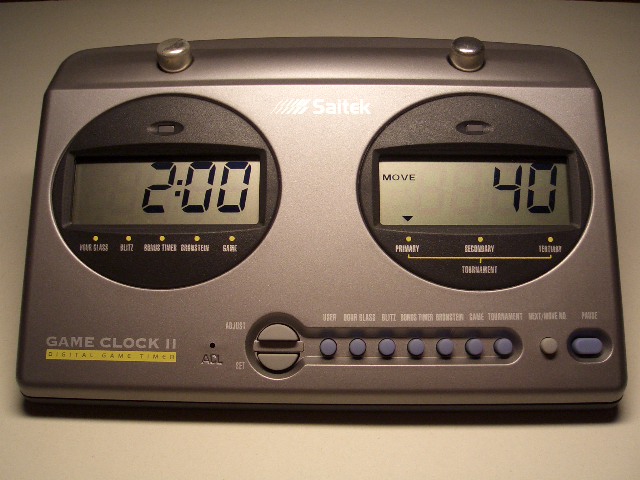
SaitekGC2Manual.pdf
|
- Older Version of Saitek Mephisto
- Large LCD Display
- Two Size C Batteries
- 12 Preset Operating Modes
- One User Programmable Mode
- Multiple Button Control
|
The Saitek Game Clock II has a row of buttons that allow direct easy access to all functions. Saitek: "Game Clock II" is an older moder, but may be nearly identical in function to the "Competition Game Clock (Scholastic Blue)", "Competition Pro Game Clock (Silver)", & "Competition Pro Game Clock III", which all appear to be different names for the same clock.
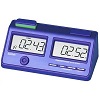
SaitekGameclockManual.pdf
|
- "Scholastic Blue" Plastic Case
- Large LCD Display
- Two Size C Batteries
- 12 Preset Operating Modes
- One User Programmable Mode
- Single Joystick Pad Control
- LED Illuminated Buttons
|
The Saitek Competition game clock has illuminated buttons that glow green when it's your move & flash red when time has expired. Saitek: "Game Clock II", "Competition Game Clock (Scholastic Blue)", "Competition Pro Game Clock (Silver)", & "Competition Pro Game Clock III" all appear to be different names for the same clock.
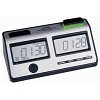
SaitekGameclockManual.pdf
|
- Plastic Case
- Large LCD Display
- Two Size C Batteries
- 22 Preset Operating Modes
- Three User Programmable Modes
- Single Joystick Pad Control
- LED Illuminated Buttons
|
The Saitek Mephisto Competition Game Clock Pro (I believe this is the same clock as the Saitek "Competition Pro Game Clock [III or Silver]" mentioned above.) has illuminated buttons that glow green when it's your move & flash red when time has expired. They are visible from all directions. Modes include: Hourglass, Blitz, & FIDE/ECU/Traditional Tournament as well as Fischer, Bronstein, Delay and Word Modes.
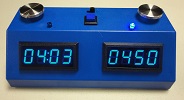
ZMF-IIManual.pdf
|
- ABS Plastic Case
- Bright LED Display
- Four Size C Batteries
- 1600 Hours Operation per Set of Batteries
- Easy To Program
- Three User Programmable Modes
- Touch Pad Buttons
|
ZmartFun Electronics, Inc. are the proud USA producers of these elegant but simple game timers. They are currently available in black, blue, red, & green with bright white, blue, red, & green LED displays respectively. Like many more expensive clocks, they can be easily set for delay, increment, hour-glass, and byo-yomi timing modes as needed.
ZmartFun Electronics, Inc. are the proud USA producers of these elegant but simple game timers. They are currently available in black, blue, & silver with large LCD displays. Like many more expensive clocks, they can be easily set for delay, increment, hour-glass, and byo-yomi timing modes as needed.
Note: As of May 15, 2018, there seems to be no user manual for the ZMF-Pro Metal case style clock. The newest manual available from Zmart Fun is v2.1 dated 09-07-15. It appears to be an updated version of the older ZMF II manual v1.4 dated 04-18-13. Until Zmart Fun issues a manual that explicitly addresses the newer ZMF-Pro Metal Case LCD style clocks, I'll assume the operation of these clocks is the same as the newer ZMF II style clocks (i.e. v2.1).
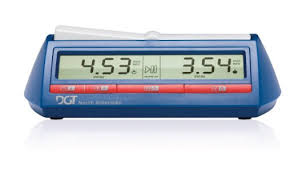
DGTNAManual.pdf
|
- LCD Display
- Two AA Batteries
- ABS Plastic Case
- 10 different algorithms covering all popular timing standards
- Manual programming of all modes
- All 10 manual settings are stored in the clock's memory
- 13 factory presets
- Move counter for all options
- Time and move counter correction option during a game
- Optional sound alert to warn for running out of time
- 16 LCD Contrast Settings
- Low battery indication
|
This is the recently released North American version of the DGT Timer. Like the FIDE version, it may be used in conjunction with a DGT Recording Electronic Chess Board. LCD Display, Two AA Batteries, ABS Plastic Case, 34 Operating Modes. The LCD Contrast is adjustable to accommodate different lighting conditions. This clock does store your personal settings, but in order to start a new game, it seems you must turn the clock off then back on & scroll through the presets to find your desired mode.
According to the actual manual for this clock:
The main difference between the DGT2010 and the DGT North American (DGT NA) is the way the delay time is displayed and the color of the cabinet.
The DGT2010 adds the remaining delay time back for the player's next turn, while the DGT NA pauses during the delay time, which is common in North American countries.
The result is exactly the same, only the way of displaying is different.
(The Fide Laws of Chess state the following: [The difference between the "Bronstein Mode" & the "Delay Mode"]
6.2. b. The time saved by a player during one period is added to his time available for the next period, except in the 'time delay' mode.
In the time delay mode both players receive an allotted 'main thinking time'. Each player also receives a 'fixed extra time' with every move. The countdown of the main time only commences after the fixed time has expired. Provided the player stops his clock before the expiration of the fixed time, the main thinking time does not change, irrespective of the proportion of the fixed time used.)
The DGT NA has less presets for different timing methods and it has no special Go and Scrabble timing methods.
The DGT North American is not FIDE approved but all options that the DGT NA has in common with the DGT2010 are according to FIDE rules and regulations.
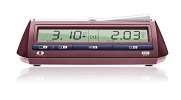
DGTManual.pdf
|
- LCD Display
- Two AA Batteries
- ABS Plastic Case
- 34 Programmble Operating Modes
- 16 LCD Contrast Settings
- Official Chess Clock of FIDE
|
The DGT Timer is the official chess clock of FIDE & may be used in conjunction with a DGT Recording Electronic Chess Board. LCD Display, Two AA Batteries, ABS Plastic Case, 34 Operating Modes. The LCD Contrast is adjustable to accommodate different lighting conditions. This clock does store your personal settings, but in order to start a new game, it seems you must turn the clock off then back on & scroll through the presets to find your desired mode.
A special DGT2010 Limited Edition is released in January 2013 to celebrate DGT's 20 year anniversary. It was produced in 2013 only.
The Limited Edition has the same options as the popular DGT2010 but is designed in a celebratory red colour.
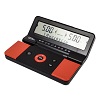
DGT960Manual.pdf
|
- Folds Up to Tiny Plastic Case
- Pre-installed Small 3v CR2032 Battery
- Supports Shuffles for Chess960
- Game Timer & Move Timer Modes
- 16 LCD Contrast Settings
- LCD Flag
- Count Up & Count Down Modes
|
The DGT 960 Timer is specifically designed to support not only typical chess & other game tournaments, but also the "fischer Random" or "Chess 960" variant which requires shuffling the pieces to generate the initial starting position. LCD Display, similar to the Standard DGT Clock above, features adjustable contrast for varying lighting conditions. The DGT 960 is far too tiny for anything like Size C or even AA batteries, so comes with a pre-installed small 3v CR2032 battery that will supposedly last for four years with average use of the sound signal. manufactured in The Netherlands, this clock is an excellent choice for someone wanting to travel light or play lots of Chess 960.
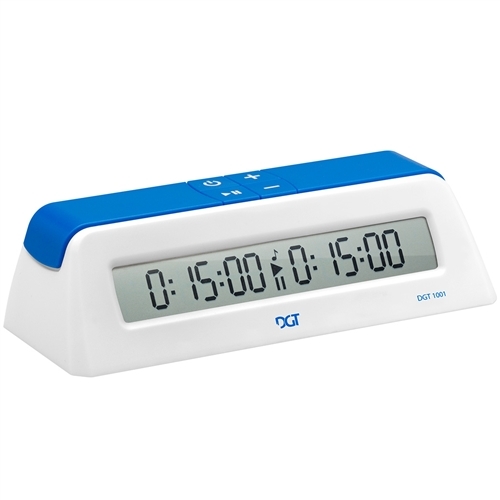
DGT960Manual.pdf
|
- Plastic Case
- One Pre-installed AA Battery
- Low Battery Indicator
- High Contrast LCD Display
- LCD Flag
- Count Up & Count Down Modes
- No Delay or Increment possible
- Initial settings only support same time on each clock
- Limited ability to add or subtract time to either clock
- Limitations may preclude use in USCF rated events
|
The DGT 1001 is a universal game timer suitable for school, club or home use. It has a crystal clear display, is extremely easy to use and very affordable. The DGT 1001 features countdown and up-count and has two large buttons on the top left and right to operate the timer.
It comes in two color versions. Battery is included. Please see the manual for more information.
The DGT 1001 does NOT include a delay feature, increment time or multiple time controls.
Important Note:
This Clock does not have Time Delay and is not recommended for US Chess Federation Rated Play.
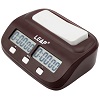
LeapPQ9907Manual.pdf
|
- Compact Plastic Case
- Light Weight, Less Than 4 Ounces
- One AAA Battery
- Fischer Mode
- Presettable Count Up / Count Down
- Preset Timing Modes
|
Made in Guangdong, China. I've only seen a few of these Leap clocks, & they look like an inexpensive version of the DGT to me except they have no provision for connection to an external electronic chess board & they appear to be available in only one color. Actual dimensions are 13.5cm x 9.5cm x 4.5cm & the weight is 135g. They come with a user manual, but I haven't found one online yet.
Note: Hugh McLaughlin informs me that:
"The Leap PQ9903B clock has the necessary features to provide the 5-sec delay that the WCC uses [as do many other rated tournaments]. The less expensive PQ9907, which has only three buttons below the display, does NOT have the delay capability."
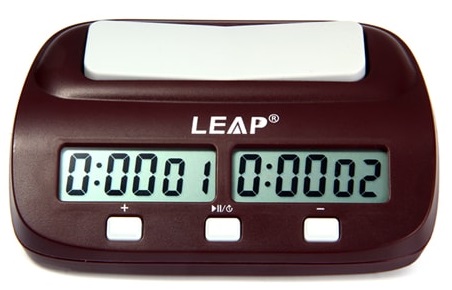
LeapPQ9907Manual.pdf
|
- Compact Plastic Case
- Light Weight, Less Than 4 Ounces
- One AAA Battery
- Fischer Mode & Simple Delay Mode
- Presettable Count Up / Count Down
- Preset Timing Modes
|
Made in Guangdong, China. I've only seen a few of these Leap clocks, & they look like an inexpensive (~$15-$20 US) version of the DGT to me except they have no provision for connection to an external electronic chess board & they appear to be available in only one color. Actual dimensions are 13.5cm x 9.5cm x 4.5cm & the weight is 135g. They come with a user manual, but I haven't found one online yet.
Note: Joerg Sonnenberger informs me that:
"The Leap PQ9907S is a slightly newer version of the 9907 you have on the list. The biggest difference is that it (PQ9907S) supports both Fischer time and simple delay mode. It can not do both bonus and delay settings at the same time though.
From the low end spectrum, I consider it much more useful than the entrance-level DGT models as it (PQ9907S) has full time control. We tend to play children tournaments with 2 minute penalties for the first two illegal moves and that's downright impossible with the 'DGT Easy' and somewhat annoying with the 'DGT 1001'."
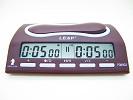
|
- Compact Plastic Case
- Two AA Batteries
- Presettable Count Up / Count Down
- Official Clock for the Chinese Chess Federation
- 29 Preset Timing Modes
|
Made in Guangdong, China. I've never seen either one of these Leap clocks, [UPDATE: I've seen numerous specimens of both types of Leap clocks.] but they look like an inexpensive version of the DGT to me except they have no provision for connection to an external electronic chess board & they appear to be available in only one color.
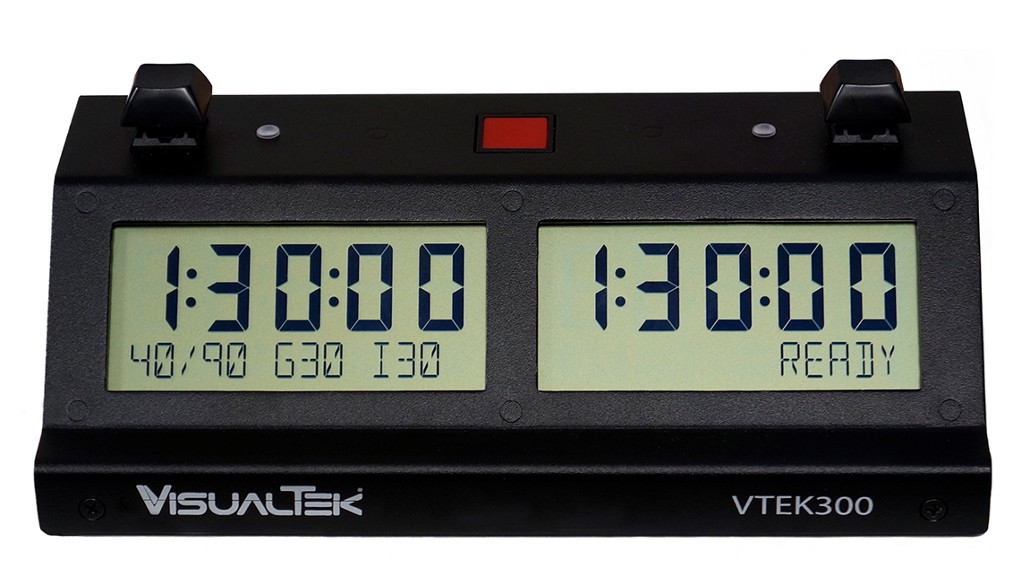
VTek300Manual.pdf
|
- Metal Case
- Super contrast LCDs
- 20 savable functions
- Highly visible LEDs
- Three AA alkaline batteries
- Low Battery indicator
- Text based menu system for ease of programming
- Simple easy to understand 6 page manual
- Quickset USCF and FIDE modes
|
"The VTEK 300 clock is the ultimate chess game clock. The large, clear display shows all the information chess players expect during play and while adjusting settings.
Setting is very intuitive and you'll feel comfortable with it in less than 10 minutes. It is designed and made in USA by experienced engineers, advised by chess players who know what a clock needs.
For those familiar with the Chronos Chess Clock, we find that this clock beats the Chronos in almost every aspect of design.
The battery life is exceptional, options are thorough and well organized. It even has multi-function lights. It's everything a player needs and then some, but without the perplexing programming. It's just easier.
850 hours of game play is estimated on 3 AA batteries. When in idle mode they should last more than 2 years. When about 12 hours of game play are remaining, a low battery warning will show. There is an easy to access battery compartment with two Philips screws. Of course, it is recommended to remove the batteries if not being used for more than a year."









